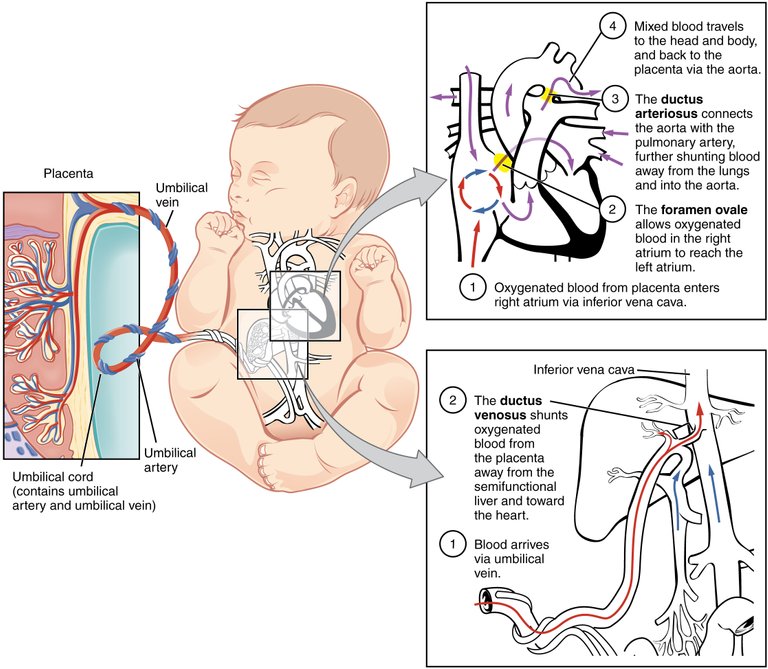Biological Growth in Humans from Fetus to Infants.
We are complex beings and we didn't fall from the sky, it all started from a single sperm and egg fertilization. After fertilization, at about 40 weeks, a life is created and this all started from a single cell which evolved to become a baby which is born. At the month of birth, babies experience a surge of adrenaline that is more intense than when a person is having a heart attack. This adrenaline helps the baby take its first breath since its lungs are still filled with amniotic fluid. That adrenaline helps to take the first of about 700 million breaths or more that would be taken in a lifetime. This breath allows air to get into the body through the Alveoli taking in oxygen into the blood and taking out carbon dioxide, and it is at this point that the mother is detached from the mother through the cutting of the Umbilical cord.
While the heart of the child has been pumping in the womb after its cardiovascular development at about 4 weeks after gestation occurs but when we are born, the heart of a child is still not strong enough. The infant has two holes in its cardiovascular system, one in the Aorta and one in the heart, and these aren't defects but a result of blood circulation from the blood vessels to the placenta helping to take away blood from the inactive lungs in the womb but since the lungs begin to function, they begin to close. The heart pumps blood to lots of blood vessels and to different organs. After the first meal which is usually breastmilk or formula in a few cases, the infants remove meconium from their body which is a corrosive substance that is flushed out within hours from the gut.
As the child grows, they start to make sense of the world around them and growth begins both outwards and inwards. Each and everyone has a unique DNA that contains instructions of how we look, character, age, develop, and even die, even though our lives are shaped by the environment. In infants, the hypothalamus is immature and can cause the child so regulating temperature might be difficult but regulating temperature is easier with infants having brown behind their shoulder blades which help keep the heat in the body, and as the hypothalamus matures, the brown fat melts away.
Infants drink about half a liter of milk on a daily basis, as the immune system is underdeveloped but the breastmilk will help to fight bacteria, and the immune system of the mother would serve as antibodies. Just like most parts of the body are not mature, the retina in the eye is not mature. The retina which is made up of rods and cones is responsible for relating colors and views to the brain. In infants, the cones are not matured, so babies cannot see colors clearly, also the brain cannot interpret data. at about 2 to 4 months, infants can begin to identify colors and facial patterns, and by 8 to 10 months, vision is complete. When it also comes to growth, in the first three months, children grow by a quarter of their body weight, and the growth rates begin to reduce as the child ages.
At 8 months to 1 year, we start to do more touches and use our mouths to explore the world. Also, the milk teeth begin to come out and at that point, we can begin to eat food. Digestion starts in the mouth, and the teeth start to grind the food and saliva breaks down and lubricate the food through the gut. The food in a process called peristalsis keeps food going into our stomach through contractions. The food goes to the stomach which is a bag of muscle that churns, squeezes, and mixes foods. The acid in the stomach breaks down the food. The food travels through the pyloric sphincter to the small intestine where nutrients are absorbed. In the small intestine, the pancreas releases pancreatic juice to neutralize the stomach acid, and bile in the liver breaks down/emulsifies fat where the nutrient is absorbed. After absorption, the remnant is sent through the ileocecal sphincter to the large intestine, and the food cannot return to the small intestine. In the large intestine, water is absorbed and waste from the food is left and is moved to the rectum, after which it goes to the anus.
At this moment, the infant's immune system is strong enough to start fighting smaller infections and diseases.
What happens to your body in childbirth
When Do Babies Take Their First Breath?
Breathing is a 24-Hour Activity by Randy Clare
Fetal cardiac function during the first trimester of pregnancy
Thyroid hormone and the developing hypothalamus
Brown Fat: What You Need to Know

Most of the time, I always find it hard to distinguish between fetus and infant
Lol!! just like it is possible to find it hard to distinguish ovum and zygote. People can mistake these things a lot. :)
Thanks for your contribution to the STEMsocial community. Feel free to join us on discord to get to know the rest of us!
Please consider delegating to the @stemsocial account (85% of the curation rewards are returned).
Thanks for including @stemsocial as a beneficiary, which gives you stronger support.